A Study the Effect of Biodiesel Blends and the Injection Timing on Performance and Emissions of Common Rail Diesel Engines
Abstract
:1. Introduction
2. Researching Method
Simulation Model of Heat Tranfer
3. Results and Discussion
3.1. Model Validation
3.2. The Effect of Biodiesel Blends
3.3. The Effect Injection Timing
4. Conclusions
Author Contributions
Funding
Institutional Review Board Statement
Informed Consent Statement
Data Availability Statement
Conflicts of Interest
References
- Nizetic, S.; Djilali, N.; Papadopoulos, A.; Rodrigues, J.J.P.C. Smart technologies for promotion of energy effciency, utilization of sustainable resources and waste management. J. Clean Prod. 2019, 231, 565–591. [Google Scholar] [CrossRef]
- Watts, N.; Amann, M.; Ayeb-Karlsson, S.; Belesova, K.; Bouley, T.; Boykoff, M.; Bypass, P.P.; Cai, W.; Campbell-Lendrum, D.; Cambers, J.; et al. The Lancet Countdown on health and climate change: From 25 years of inaction to a global transformation for public health. Lancet 2018, 391, 581–630. [Google Scholar] [CrossRef]
- Rajaeifar, M.A.; Tabatabaei, M.; Aghbashlo, M.; Nizami, A.-S.; Heidrich, O. Emissions from urban bus fleets running on biodiesel blends under real-world operating conditions: Implications for designing future case studies. Renew. Sustain. Energy Rev. 2019, 111, 276–292. [Google Scholar] [CrossRef]
- Aghbashlo, M.; Tabatabaei, M.; Mohammadi, P.; Mirzajanzadeh, M.; Ardjmand, M.; Rashidi, A. Effect of an emission-reducing soluble hybrid nanocatalyst in diesel/biodiesel blends on exergetic performance of a DI diesel engine. Renew. Energy 2016, 93, 353–368. [Google Scholar] [CrossRef]
- Aghbashlo, M.; Hosseinpour, S.; Tabatabaei, M.; Mojarab Soufyan, M. Multi-objective exergetic and technical optimization of a piezoelectric ultrasonic reactor applied to synthesize biodiesel from waste cooking oil (WCO) using soft computing techniques. Fuel 2019, 235, 100–112. [Google Scholar] [CrossRef]
- Aghbashlo, M.; Tabatabaei, M.; Khalife, E.; Roodbar Shojaei, T.; Dadak, A. Exergoeconomic analysis of a DI diesel engine fueled with diesel/biodiesel (B5) emulsions containing aqueous nano cerium oxide. Energy 2018, 149, 967–978. [Google Scholar] [CrossRef]
- Van Gerpen, J. Biodiesel processing and production. Fuel Process Technol. 2005, 86, 1097–1107. [Google Scholar] [CrossRef]
- Aghbashlo, M.; Shamshirband, S.; Tabatabaei, M.; Yee, L.; Larimi, Y.N. The use of ELMWT (extreme learning machine with wavelet transform algorithm) to predict exergetic performance of a DI diesel engine running on diesel/biodiesel blends containing polymer waste. Energy 2016, 94, 443–456. [Google Scholar] [CrossRef]
- Demirbas, A. Importance of biodiesel as transportation fuel. Energy Policy 2007, 35, 4661–4670. [Google Scholar] [CrossRef]
- Aghbashlo, M.; Tabatabaei, M.; Hosseinpour, S. On the exergoeconomic and exergoenvironmental evaluation and optimization of biodiesel synthesis from waste cooking oil (WCO) using a low power, high frequency ultrasonic reactor. Energy Convers Manag. 2018, 164, 385–398. [Google Scholar] [CrossRef]
- Krahl, J.; Munack, A.; Schröder, O.; Stein, H.; Bunger, J. Influence of biodiesel and different designed diesel fuels on the exhaust gas emissions and health effects. SAE Pap. 2003, 112, 2447–2455. [Google Scholar]
- Lin, B.-F.; Huang, J.-H.; Huang, D.-Y. Experimental study of the effects of vegetable oil methyl ester on DI diesel engine performance characteristics and pollutant emissions. Fuel 2009, 88, 1779–1785. [Google Scholar] [CrossRef]
- Jeon, J.; Park, S. Effect of injection pressure on soot formation/oxidation characteristics using a two-color photometric method in a compression-ignition engine fueled with biodiesel blend (B20). Appl. Therm. Eng. 2018, 131, 284–294. [Google Scholar] [CrossRef]
- ASTM D7467-18b. Standard Specification for Diesel Fuel Oil, Biodiesel Blend (B6 to B20). ASTM International (ASTM): West Conshohocken, PA, USA, 2018.
- Khoa, N.X.; Lim, O. Comparative Study of the Effective Release Energy, Residual Gas Fraction, and Emission Characteristics with Various Valve Port Diameter-Bore Ratios (VPD/B) of a Four-Stroke Spark Ignition Engine. Energies 2020, 13, 1330. [Google Scholar] [CrossRef] [Green Version]
- Khoa, N.X.; Lim, O.T. Effective release energy, residual gas, and engine emission characteristics of a V-twin engine with various exhaust valve closing timings. J. Mech. Sci. Technol. 2020, 34, 477–488. [Google Scholar] [CrossRef]
- Khoa, N.X.; Lim, O. The Internal Residual Gas and Effective Release Energy of a Spark-Ignition Engine with Various Inlet Port–Bore Ratios and Full Load Condition. Energies 2021, 14, 3773. [Google Scholar] [CrossRef]
- Khoa, N.X.; Lim, O.T. The effects of bore-stroke ratio on effective release energy, residual gas, peak pressure rise and combustion duration of a V-twin engine. J. Mech. Sci. Technol. 2020, 34, 2657–2666. [Google Scholar] [CrossRef]
- Theory-AVL Boost Version 2011.1. Available online: https://www.avl.com/boost (accessed on 20 March 2020).
- Sridharan, G.; Chandramouli, R.; Mohamed, M.M.; Ashok, K.T. Performance, Combustion and Emission Characteristics of a Single Cylinder CI Engine Running on Diesel-Biodiesel-Water Emulsion with Additive. Available online: https://www.tandfonline.com/doi/full/10.1080/15567036.2019.1704948 (accessed on 20 March 2020).
- Mohammad, S.; Tarahom, M.G.; Ahmad, J.; Aram, H.-M. Performance and emission characteristics of a diesel engine fueled with functionalized multi-wall carbon nanotubes (MWCNTs-OH) and diesel–biodiesel–bioethanol blends. Energy Rep. 2020, 6, 1438–1447. [Google Scholar]
- Nguyen, T.N.; Khoa, N.X.; Tuan, L.A. The Correlation of Biodiesel Blends with the Common Rail Diesel Engine’s Performance and Emission Characteristics. Energies 2021, 14, 2986. [Google Scholar] [CrossRef]
- Yesilyurt, M.K.; Aydin, M. Experimental investigation on the performance, combustion and exhaust emission characteristics of a compression-ignition engine fueled with cottonseed oil biodiesel/diethyl ether/diesel fuel blends. Energy Convers. Manag. 2020, 205, 112355. [Google Scholar] [CrossRef]
- Mendecka, B.; Lombardi, L.; Kozioł, J. Probabilistic multi-criteria analysis for evaluation of biodiesel production technologies from used cooking oil. Renew. Energy 2020, 147, 2542–2553. [Google Scholar] [CrossRef]
- Gharehghani, A.; Mirsalim, M.; Hosseini, R. Effects of waste fish oil biodiesel on diesel engine combustion characteristics and emission. Renew. Energy 2017, 101, 930–936. [Google Scholar] [CrossRef]
- Sanli, H.; Canakci, M.; Alptekin, E.; Turkcan, A.; Ozsezen, A.N. Effects of waste frying oil based methyl and ethyl ester biodiesel fuels on the performance, combustion and emission characteristics of a DI diesel engine. Fuel 2015, 159, 179–187. [Google Scholar] [CrossRef]
- Rajesh Kumar, B.; Saravanan, S.; Rana, D.; Nagendran, A. Use of some advanced biofuels for overcoming smoke/NOx trade-off in a light-duty DI diesel engine. Renew. Energy 2016, 96, 687–699. [Google Scholar] [CrossRef]
- Nguyen, T.N.; Pham, P.M.; Tuan, L.A. Spray, combustion, performance and emission characteristics of a common rail diesel engine fueled by fish-oil biodiesel blends. Fuel 2020, 269, 117108. [Google Scholar] [CrossRef]
- Can, Ö.; Öztürk, E.; Yücesu, H.S. Combustion and exhaust emissions of canola biodiesel blends in a single cylinder DI diesel engine. Renew. Energy 2017, 109, 73–82. [Google Scholar] [CrossRef]
- Suresh, M.; Jawahar, C.P.; Richard, A. A review on biodiesel production, combustion, performance, and emission characteristics of non-edible oils in variable compression ratio diesel engine using biodiesel and its blends. Renew. Sustain. Energy Rev. 2018, 92, 38–49. [Google Scholar] [CrossRef]
- Jiaqiang, E.; Minh-Hieu, P.; Yuanwang, D.; Tuannghia, N.; Vinh-Nguyen, D.; Duc-Hieu, L.; Wei, Z.; Qingguo, P.; Zhiqing, Z. Effects of injection timing and injection pressure on performance and exhaust emissions of a common rail diesel engine fueled by various concentrations of fish-oil biodiesel blends. Energy 2018, 149, 979–989. [Google Scholar]
- Agarwal, A.K.; Dhar, A.; Gupta, J.G.; Kim, W.I.; Choi, K.; Lee, C.S.; Park, S. Effect of fuel injection pressure and injection timing of Karanja biodiesel blends on fuel spray, engine performance, emissions and combustion characteristics. Energy Convers. Manag. 2015, 91, 302–314. [Google Scholar] [CrossRef]
- Zuo, Q.; Xie, Y.; Jiaqiang, E.; Zhu, X.; Zhang, B.; Tang, Y.; Zhu, G.; Wang, Z.; Zhang, J. Effect of different exhaust parameters on NO conversion efficiency enhancement of a dual-carrier catalytic converter in the gasoline engine. Energy 2020, 191, 116521. [Google Scholar] [CrossRef]

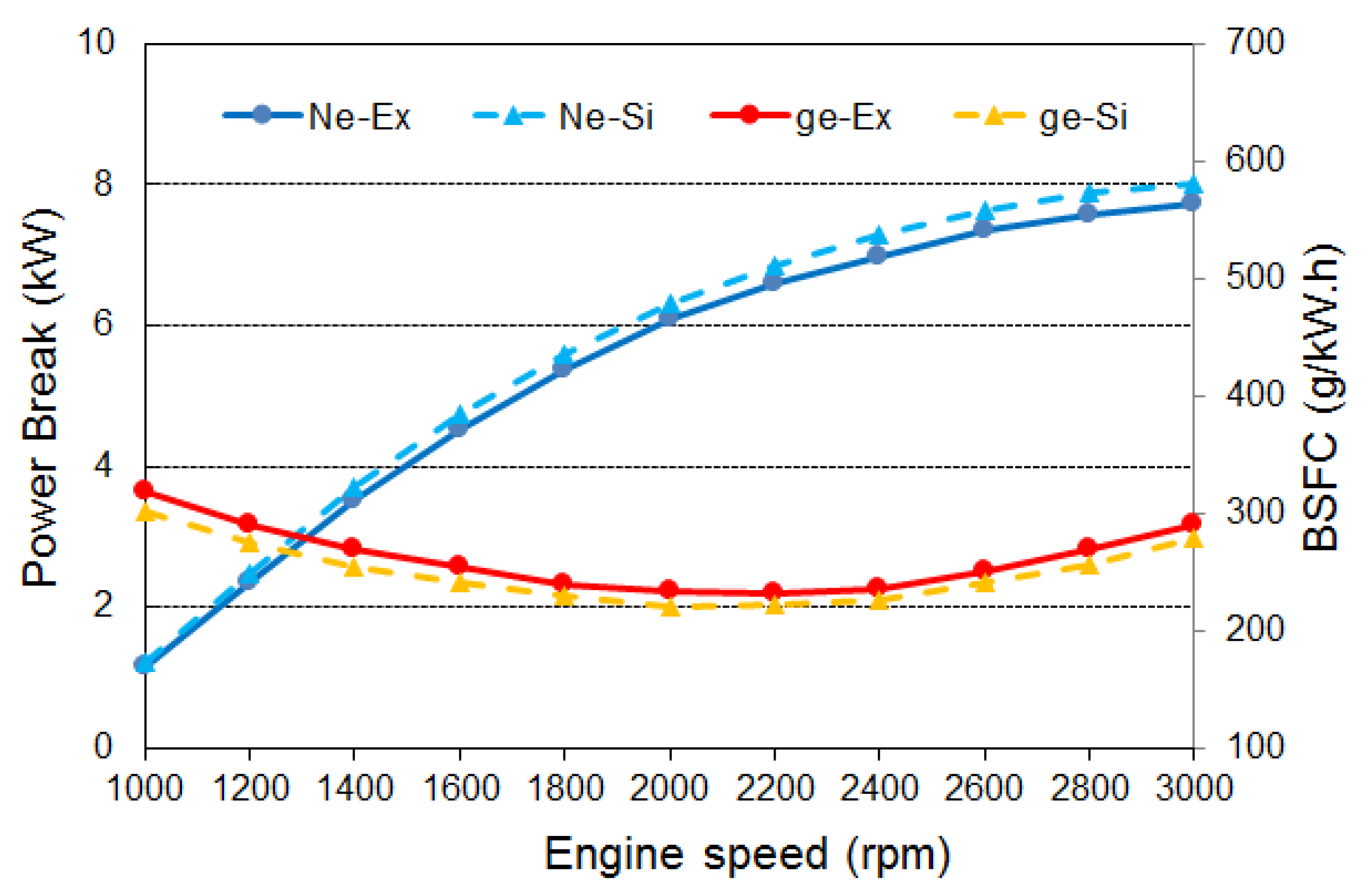


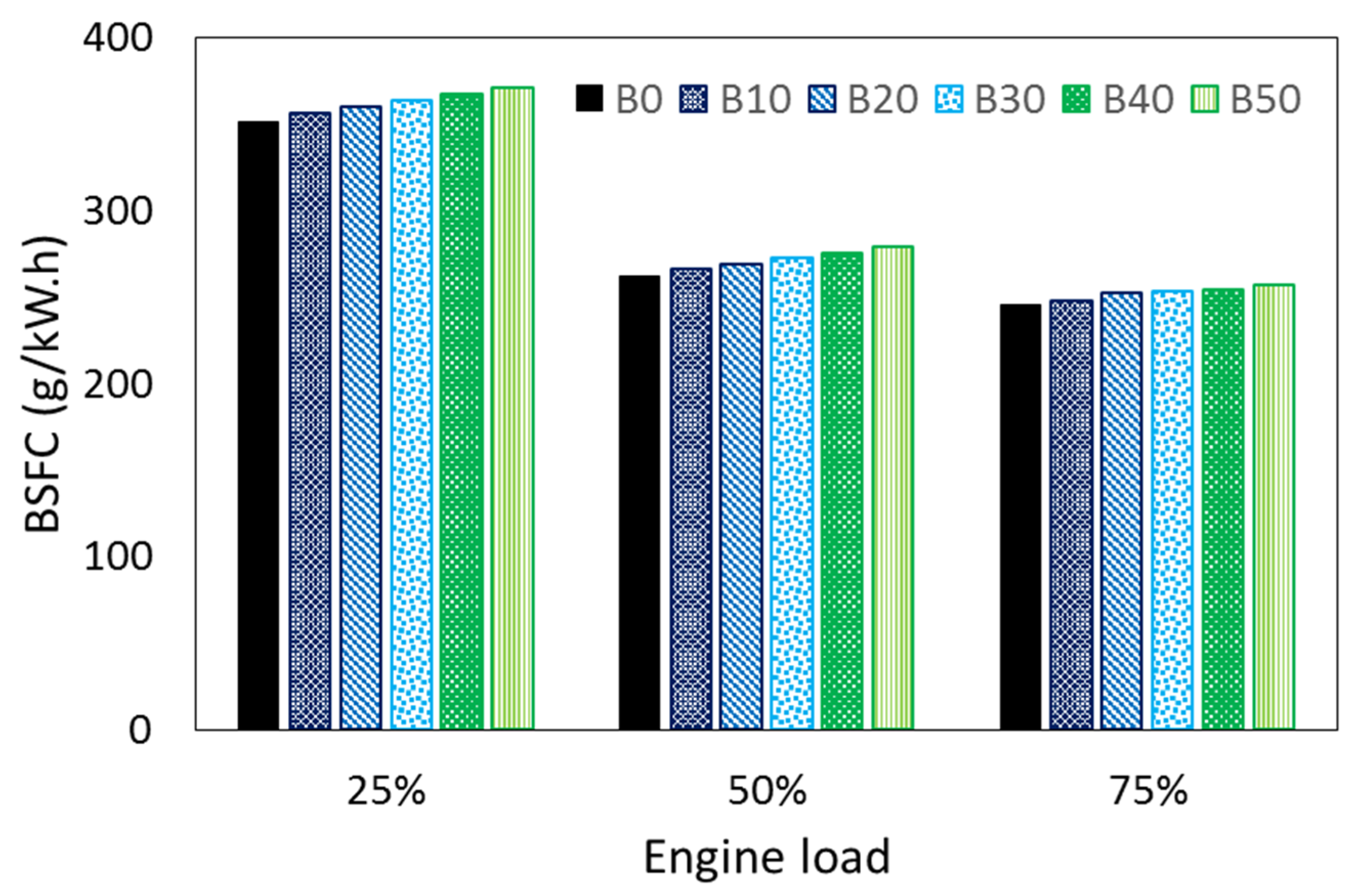
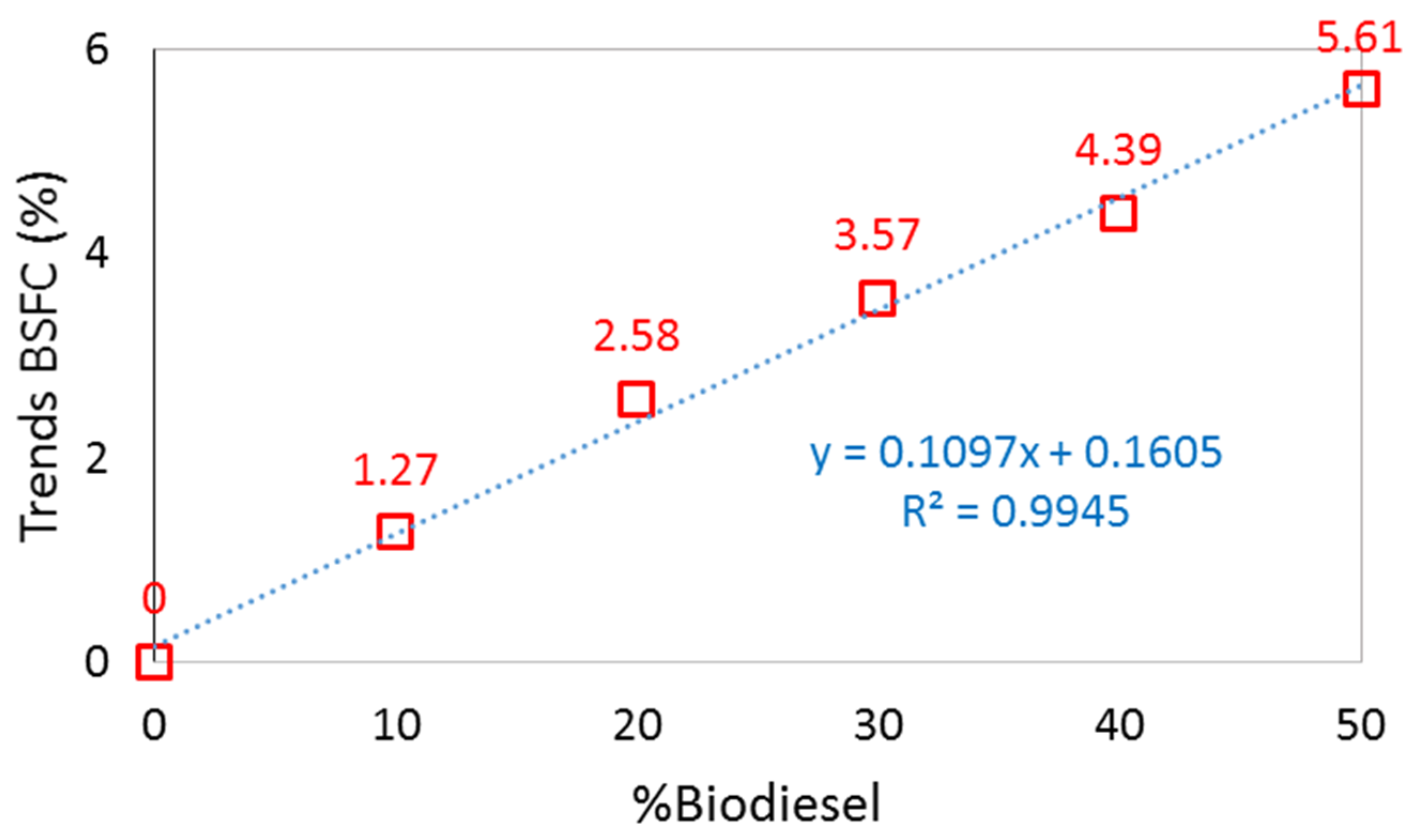
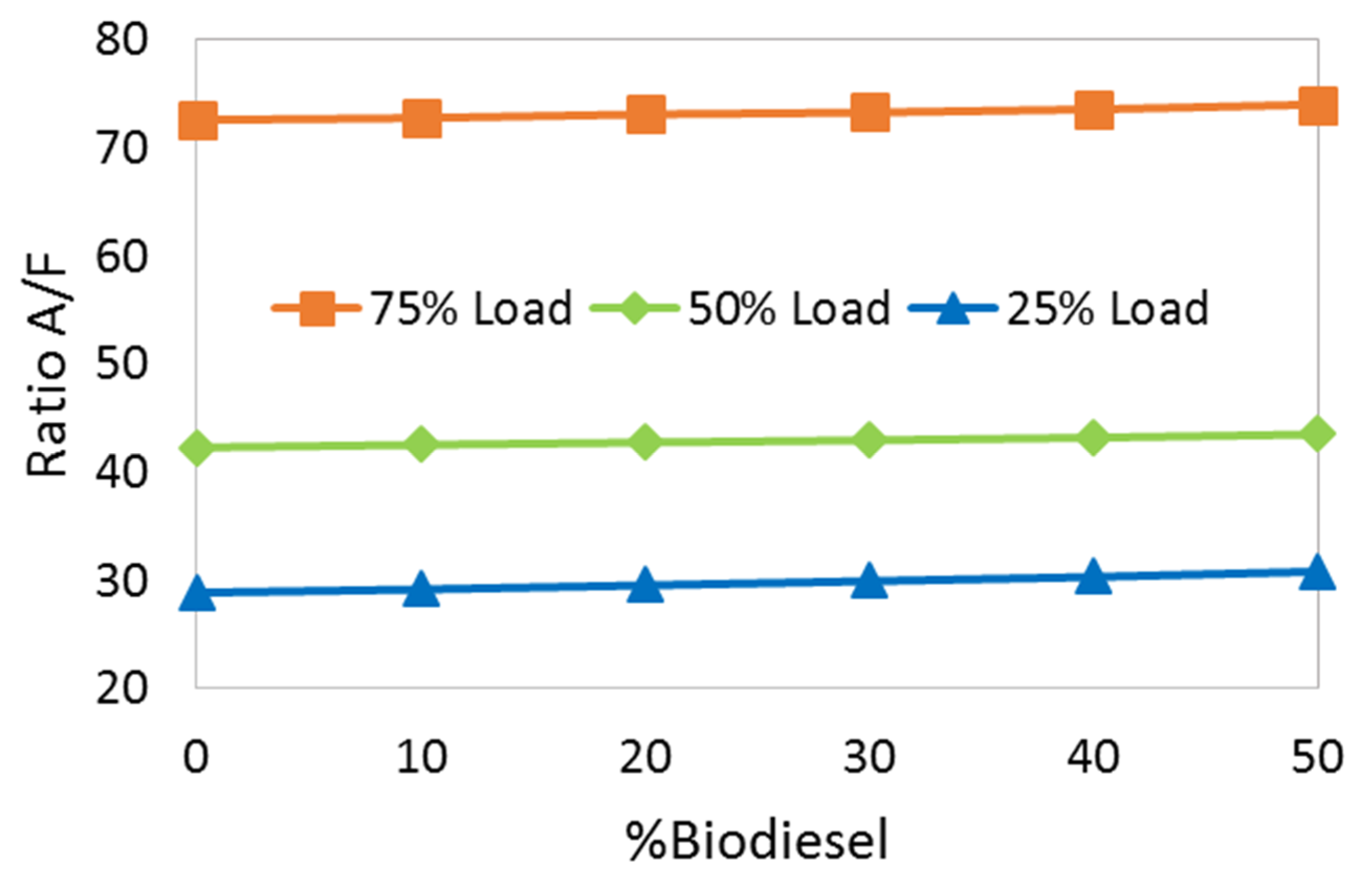


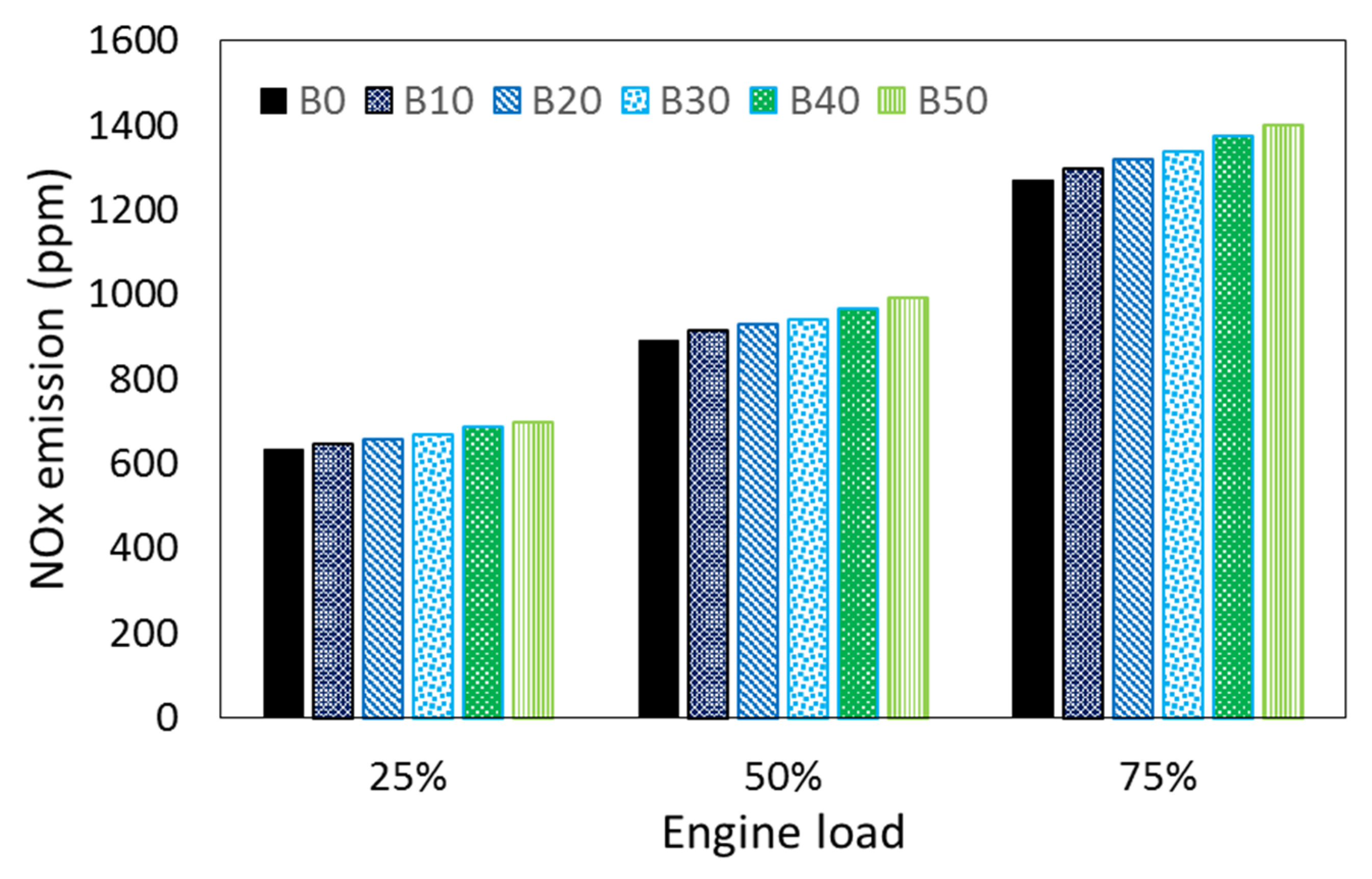
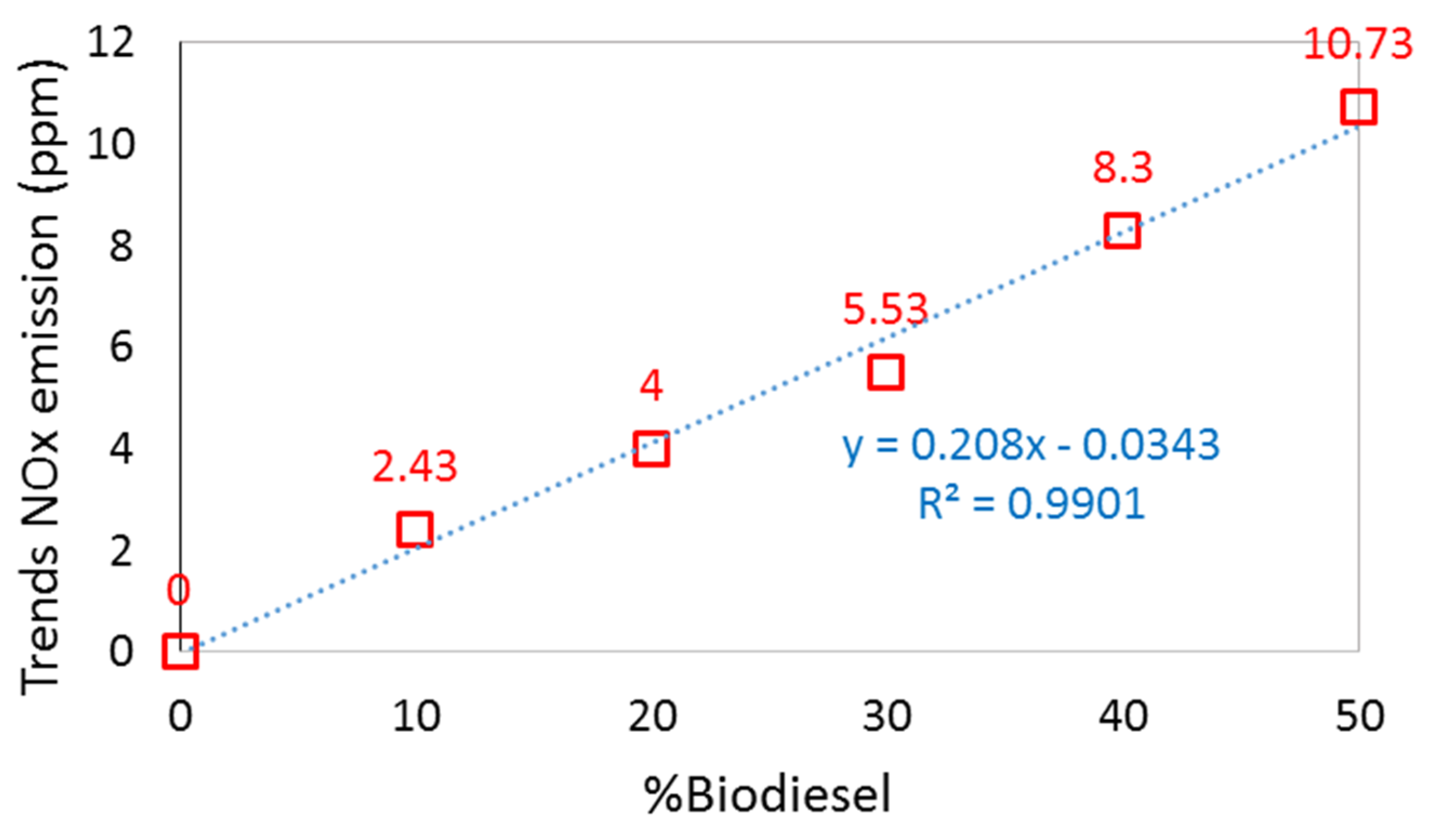
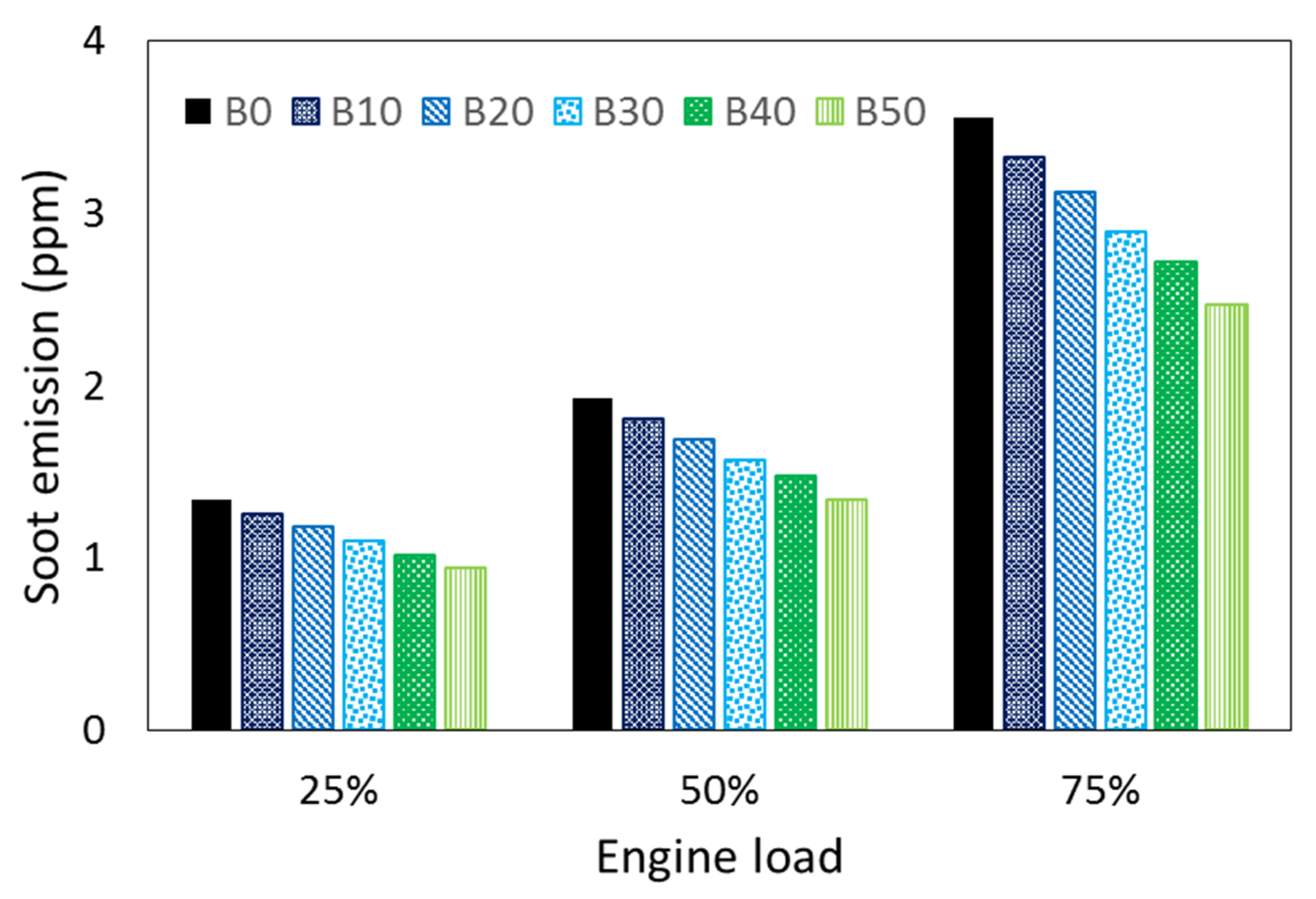
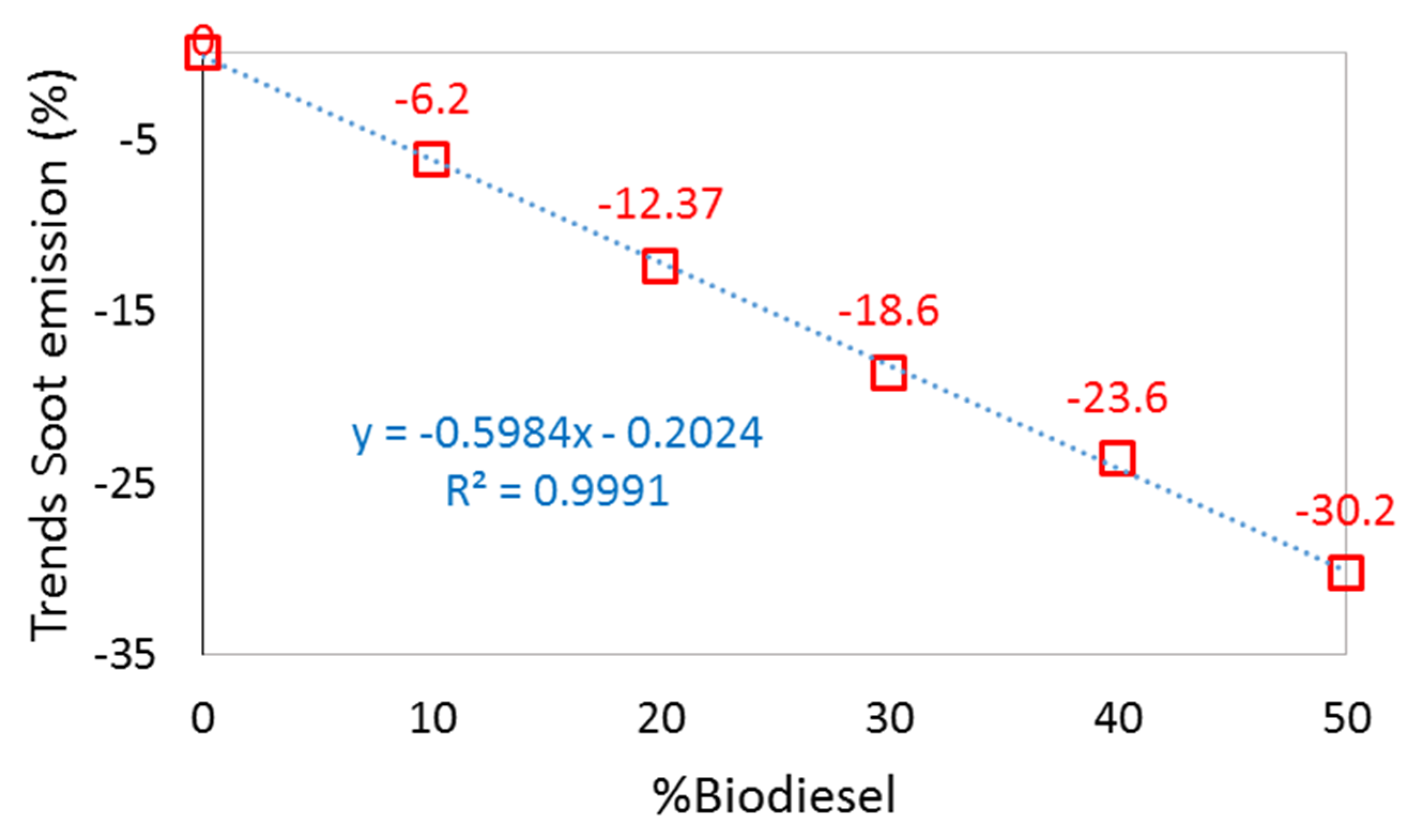
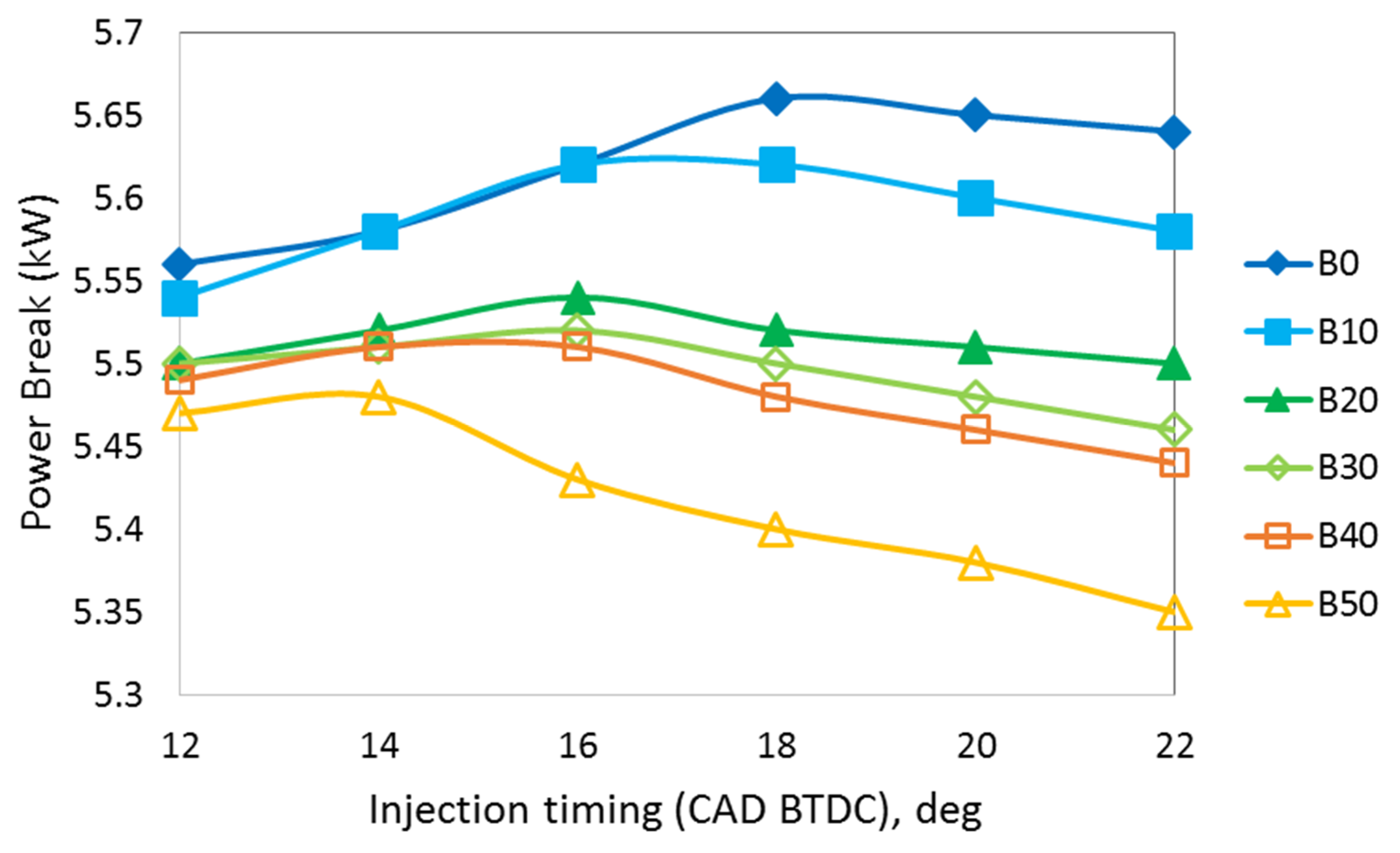

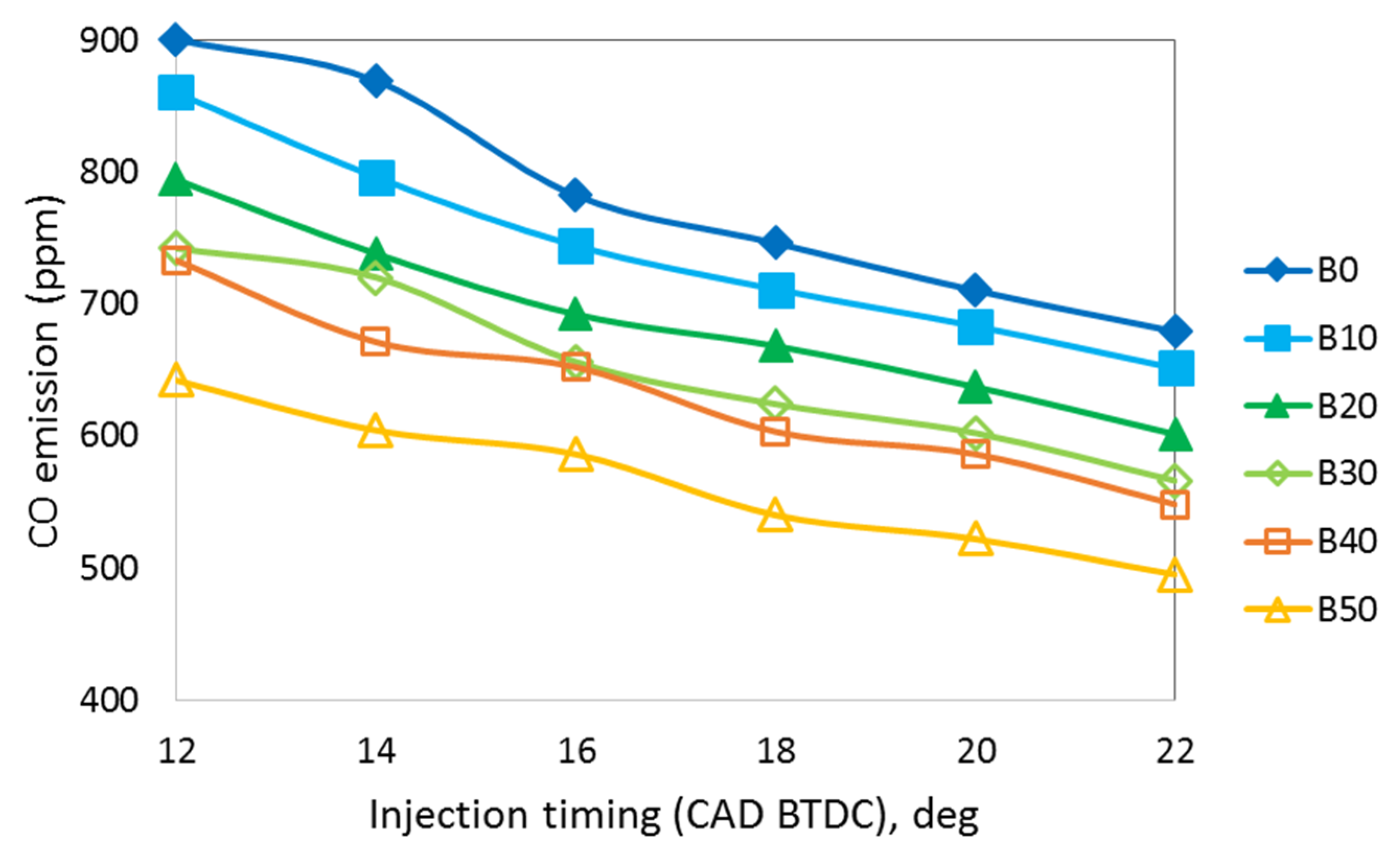



| N° | Parameter | Value |
|---|---|---|
| 1 | Bore | 85 mm |
| 2 | Stroke (S) | 90 mm |
| 3 | Volume of Displacement | 510.7 cm3 |
| 4 | Compression ratio | 17:1 |
| 5 | Rate power/speed | 9/3200 kW/rpm |
| Property | Unit | Method | B0 | B10 | B20 | B30 | B40 | B50 | B100 |
|---|---|---|---|---|---|---|---|---|---|
| Heating value | MJ/kg | ASTM D240 | 42.76 | 42.26 | 41.84 | 41.29 | 41.03 | 41.29 | 37.58 |
| Cetane value | ASTM D613 | 49 | 50 | 51 | 52 | 53 | 54 | 56 | |
| Density at 15 °C | kg/m3 | ASTM D1298 | 838 | 840 | 845 | 848 | 852 | 857 | 866 |
| Kinematic viscosity at 40 °C | ASTM D445 | 3.22 | 3.31 | 3.47 | 3.56 | 3.67 | 3.76 | 4.40 | |
| Flash point | cSt | ASTM D93 | 67 | 71 | 75 | 80 | 84 | 89 | 142 |
| Sulfur content | ppm | ASTM D5453 | 428 | 430 | 433 | 436 | 439 | 441 | 26 |
| Water content | ppm | ASTM D6304 | 62 | 84 | 96 | 110 | 122 | 136 | 215 |
| Speed (rpm) | Fuel Supplied to the Cycle, gct (g) at Part Loads | ||
|---|---|---|---|
| 75% | 50% | 25% | |
| 2200 | 0.0175 | 0.01225 | 0.00715 |
Publisher’s Note: MDPI stays neutral with regard to jurisdictional claims in published maps and institutional affiliations. |
© 2021 by the authors. Licensee MDPI, Basel, Switzerland. This article is an open access article distributed under the terms and conditions of the Creative Commons Attribution (CC BY) license (https://creativecommons.org/licenses/by/4.0/).
Share and Cite
Nghia, N.T.; Khoa, N.X.; Cho, W.; Lim, O. A Study the Effect of Biodiesel Blends and the Injection Timing on Performance and Emissions of Common Rail Diesel Engines. Energies 2022, 15, 242. https://doi.org/10.3390/en15010242
Nghia NT, Khoa NX, Cho W, Lim O. A Study the Effect of Biodiesel Blends and the Injection Timing on Performance and Emissions of Common Rail Diesel Engines. Energies. 2022; 15(1):242. https://doi.org/10.3390/en15010242
Chicago/Turabian StyleNghia, Nguyen Tuan, Nguyen Xuan Khoa, Wonjun Cho, and Ocktaeck Lim. 2022. "A Study the Effect of Biodiesel Blends and the Injection Timing on Performance and Emissions of Common Rail Diesel Engines" Energies 15, no. 1: 242. https://doi.org/10.3390/en15010242





